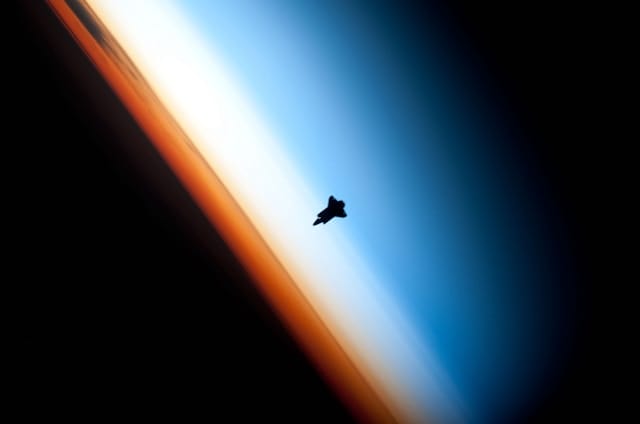Earth Orbits 101

Sebastian Gutierrez
Published: Apr 7, 2025

What Are Earth Orbits?
An orbit is a path one object takes around another object under the influence of gravity.
For Earth, these orbits include a range of altitudes where satellites, stations, and spacecraft can travel.
As these objects travel in different orbits, each will have different speeds, use cases, and gravitational environments.
Earth’s gravity doesn’t “turn off” in orbit. In fact, the ISS still experiences about 90% of Earth’s surface gravity.
Objects in orbit feel “weightless” because they’re in freefall as they are constantly falling around Earth.
Why Does It Matter?
Understanding orbits is critical for:
- Designing space stations, CubeSats, and experiments
- Predicting how much artificial gravity you might need at different altitudes
- Deciding where you’ll launch, operate, and collect data
The orbit you choose affects:
- Gravity
- Radiation
- Communication delay
- Atmospheric drag
- Access time and cost
Types of Orbits Around Earth
| Orbit | Altitude Range | Common Use |
|---|---|---|
| LEO (Low Earth Orbit) | 160–2,000 km | ISS, CubeSats, Starlink |
| MEO (Medium Earth Orbit) | 2,000–35,786 km | GPS satellites |
| GEO (Geostationary Orbit) | ~35,786 km | Weather, comms, fixed-position satellites |
| HEO (Highly Elliptical Orbit) | Variable | Polar & spy satellites |
| Cislunar | Earth–Moon region | Lunar prep missions |
Earth’s Gravitational Pull at Sea Level for the ISS
We start by calculating the gravitational force (i.e., the weight) acting on the ISS if it were at sea level.
The ISS has a certain mass, $m_i$.
$$
g_0 = \frac{G * m_e * m_i}{{r_e}^2}
$$
Where:
- Universal Gravitational Constant: $G$ = $(6.6743 ± 0.00015) × 10^{−11}, \text{m}^3 \text{kg}^{−1} \text{s}^{−2}$
- Earth’s mass: $\ m_e = 5.972 × 10^{24}, \text{kg} $
- Earth’s radius: $\ r = 6,378 \text{km} $
- ISS Mass: $\ m_i = 419,725, \text{kg} $
Plugging everything in, we get roughly $4,112,646$ $\text{N}$, where N is Newtons which is expressed as $\text{kg} \cdot \frac{\text{m}}{\text{s}^2}$, which is the gravitational force Earth exerts on the ISS at sea level.
But when most people refer to ‘gravity,’ they’re usually talking about gravitational acceleration.
Which is how much an object would accelerate if it were falling.
To get that, we divide the force by mass:
$$
F = ma => a = \frac{F}{m}
$$
Plugging in our values, we get:
$$
\frac{4,112,646}{419,725} = 9.798429967 \frac{\text{m}}{\text{s}^2}
$$
Which matches the gravitational acceleration at Earth’s surface that you’re familiar with, approximately $\ g_0 \approx 9.8 , \text{m/s}^2 $.
So although the gravitational force depends on the object’s mass, the gravitational acceleration is the same for any object near Earth’s surface (assuming no air resistance).
Calculating Gravitational Pull in relation to Earth Gravity
To figure out the Gravitational Pull of something in orbit in relation to gravity on the Earth’s surface, we have to do a bit of algebraic manipulation.
We’ll use the International Space Station (ISS) from the first example, but instead of using the number we calculated on the Earth’s surface, we’ll use the symbol $g_0$.
We’ll call gravitational pull of Earth on the ISS at the current ISS Orbit as $g_i$ using the ISS’s mass $m_i$ and the distance the ISS is above the Earth’s sea level as $r_i$.
The gravitational pull on the ISS can be calculated as
$$
g_i = \frac{G * m_e * m_i}{(r_e + r_i)^2}
$$
Where:
- Universal Gravitational Constant: $G$ = $(6.6743 ± 0.00015) × 10^{−11}, \text{m}^3 \text{kg}^{−1} \text{s}^{−2}$
- Earth’s mass: $\ m_e = 5.972 × 10^{24}, \text{kg} $
- Earth’s radius: $\ r_e = 6,378 \text{km} $
- ISS Mass: $\ m_i = 419,725, \text{kg} $
- ISS’s orbit: $\ r_i = ~420$ $\text{km} $ i.e. the height above Earth’s surface
Notice that the top of the fraction looks very much like the top of the fraction we used in the previous section.
Re-arraging the previous section’s initial equation, we can go from
$$
g_0 = \frac{G * m_e * m_i}{{r_e}^2}
$$
to
$$
g_0 \cdot {r_e}^2 = G * m_e * m_i
$$
Substituting that into the equation for $g_i$ , we get:
$$
g_i = g_0 \cdot \frac{{r_e}^2}{(r_e + r_i)^2}
$$
which is great, because the masses of the Earth and ISS disappeared, so we don’t need to know the mass of the object in orbit, as long as we’re comparing it to Earth’s gravitational acceleration.
Note that this Gravitational force follows the inverse square law.
We’ll do the numerical calculations in the next section.
Gravitational Pull at Each Orbit
From the above math, we can now calculate the Gravity exerted at each Orbital Boundary, based on % of Earth’s gravity.
Remember, from before, that:
| Orbit | Altitude Range | Common Use |
|---|---|---|
| LEO (Low Earth Orbit) | 160–2,000 km | ISS, CubeSats, Starlink |
| MEO (Medium Earth Orbit) | 2,000–35,786 km | GPS satellites |
| GEO (Geostationary Orbit) | ~35,786 km | Weather, comms, fixed-position satellites |
| HEO (Highly Elliptical Orbit) | Variable | Polar & spy satellites |
Doing some calculations (exercise left to the reader), we get:
| Orbit | Altitude (km) | Gravity (% of Earth) |
|---|---|---|
| Sea Level | 0 | 100% (1.00 G) |
| LEO Entry | 160 | ~95% (0.95 G) |
| ISS (~420 km) | 420 | ~90% (0.90 G) |
| 1,000 km | 1,000 | ~82% (0.82 G) |
| LEO Exit | 2,000 | ~58% (0.58 G) |
| MEO Entry | 2,000 | ~58% (0.58 G) |
| 10,000 km | 10,000 | ~20% (0.20 G) |
| MEO Exit | 35,786 | ~2.3% (0.023 G) |
| GEO Entry | 35,786 | ~2.3% (0.023 G) |
| Moon Orbit | 384,400 | ~0.03% (0.0003 G) |
From these calculations and the table, we can see that even at the altitude of the ISS, Earth’s gravity remains surprisingly strong.
We’ll explore why astronauts aboard the ISS experience microgravity, often called “zero gravity”, in the next journal post.
For now, it’s helpful to understand two key points:
- a) In space, gravity hasn’t disappeared. It’s still very much present.
- b) Knowing how gravity changes with altitude is essential for orbital mechanics, satellite design, and planning missions beyond Earth.
Common Misconceptions
-
❌ “There’s no gravity in orbit.”
✅ Gravity is always present. Objects are in freefall, not outside Earth’s pull. -
❌ “LEO and GEO are pretty similar.”
✅ They differ in gravity, speed, latency, radiation, and mission profile. -
❌ “Only big agencies can access orbit.”
✅ CubeSats and rideshare launches have democratized LEO access.
How Spark Gravity Connects to This
At Spark Gravity, we’re designing gravity systems that take orbit into account.
In LEO, you don’t escape gravity, you fall with it. That opens up new research environments:
- 0G (microgravity) = no effective gravity
- 0.38G (Mars equivalent) = simulate with rotation
- 1G = our baseline
We need to understand how gravity behaves at each orbit to build effective artificial gravity labs. And we’re starting by measuring it ourselves. First on Earth and then in orbit.
Want to Go Deeper?
Stay in orbit with Spark Gravity
Subscribe for new posts, interviews, and updates on artificial gravity, space infrastructure, and orbital research.
No spam. Just updates on space, science, and the future of gravity.